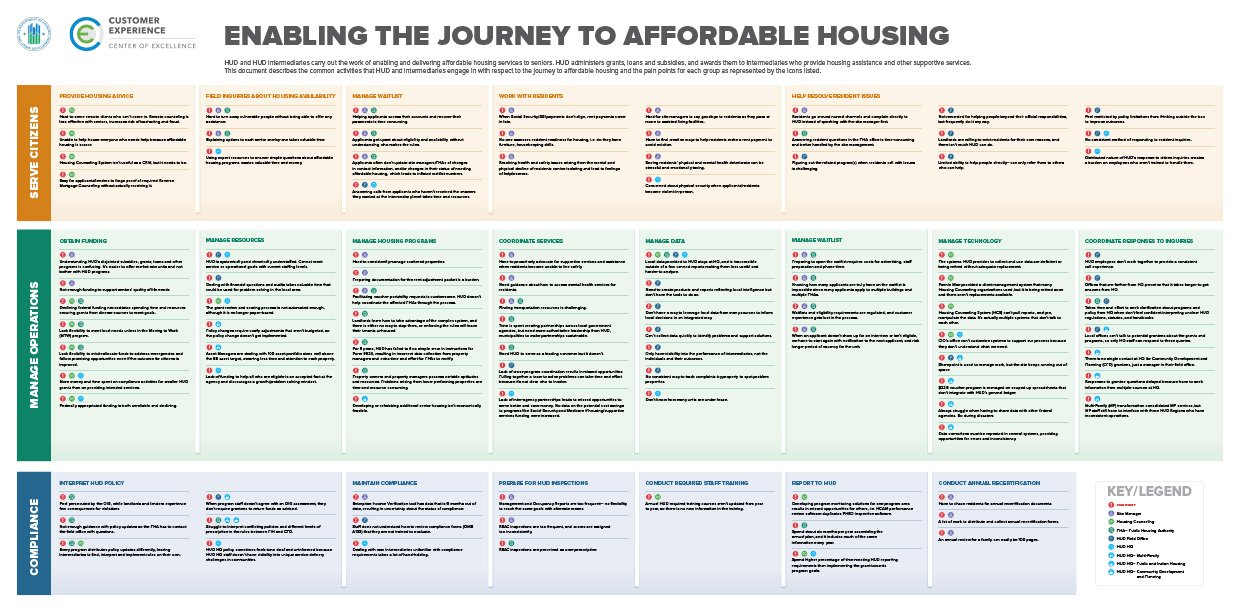The Journey to Affordable Housing for Seniors
By The HUD Customer Experience Center of Excellence Team
An Outside-In Approach to Improving HUD Operations and Transforming Customer Experience
The Customer Experience Center of Excellence (CX CoE) is supporting the U.S. Department of Housing and Urban Development (HUD) in developing the agency’s capacity to design high-value customer experiences and the ecosystems to deliver them. To demonstrate how the CX approach can be applied at HUD, the CX CoE focused on the experience of very low-income seniors seeking and living in HUD-assisted housing. Seniors are a large and growing population, and 60% have low to moderate income. Their challenges would serve as a case study and as the bellwether for system-wide opportunities. The journey of very low- income seniors also touches multiple HUD programs and offers an opportunity to tackle cross-cutting challenges.
Using human-centered design (HCD) research methods, the CoE team interviewed very low-income seniors, intermediaries who facilitate HUD programs that serve seniors, and HUD representatives to understand the activities and challenges involved in navigating HUD’s affordable housing programs. The learnings from this research were visualized in a journey map and via a service blueprint.
Caption: This is the journey map the team developed that identified the experience for seniors exploring housing options from application, waiting times, eligibility acceptance, to move-in.
Our research revealed that very low-income seniors make important housing decisions with limited, disjointed information, making it difficult to search, filter, and track the best opportunities. Uncertainty about eligibility, waitlist status and long waiting periods, commonly 5-10 years, leave them anxious. Move-in expenses can create additional financial burden. In addition, the CX CoE research found that tenants have difficulty resolving challenges with property managers, leading to escalation at HUD offices. The distributed nature of HUD’s response to citizen inquiries ends up creating a burden on employees who aren’t trained to handle them, and don’t have a systematic way to detect and address endemic problems. On the upside, the quality of life that is available to seniors in HUD-assisted housing helps the government reduce dependence on healthcare, social, and homeless services.
Meanwhile, intermediaries such as public and private housing site managers, landlords, public housing authority staff, and housing counseling providers on the front lines feel inadequately prepared or supported to deal with the physical and mental decline of senior residents. Additionally, compliance is a major portion of the work of all intermediaries that often diverts time and resources away from serving seniors and improving operations. A partnership with HUD feels asymmetrical to intermediaries who feel that HUD does not always understand their needs, has no systematic way of collecting or incorporating feedback, nor is data accessible or open to them. According to both seniors and intermediaries, the system benefits those who become experts in navigating the complexities of HUD programs.
The below represents challenges that intermediaries and HUD field employees frequently face in navigating HUD programs.
Caption: HUD field office and community partner actions supporting the citizen experience, and corresponding pain points.
The journey map and service blueprint serve as jumping off points for making meaningful improvements to customer service, program requirements, internal and external collaboration, systems and processes. In the next update, we will delve into the aforementioned opportunities, share additional findings, and include the CX CoE’s recommended enhancements.
Return to Updates


